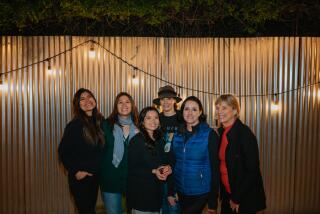Charity: New Ways Sought to Slice Pie : Conference: Officials of foundations, nonprofit groups ask how women’s programs can get more dollars.
No matter how the philanthropic pie is sliced, when it’s time to dish it out, only small pieces seem to wind up on the plates of women’s programs.
Women constitute 51% of the population, and they and the children in their care account for 75% of the nation’s 32 million poor.
Yet, in 1987, of $2.58 billion given away by 473 independent, company-sponsored and community foundations, only 3.4%--or about $87 million--went specifically to programs for women and girls, according to the national Foundation Center’s Grants Index. The figure has increased by one-half of 1% since 1981.
Both service providers and foundation professionals--such as Women and Foundations/Corporate Philanthropy, an association of grant-makers--say this relates directly to who does the slicing.
In a report released earlier this year on the need to diversify philanthropic leadership, the association said that of 723 grant-making institutions recently surveyed, women composed only 29% of the governing boards.
And of the 75 largest private, corporate and company foundations in the country, 80% of the trustees were male, and 23% of the foundations either had no women or no people of color.
The report also reprinted a 1930 description of the typical foundation trustee:
. . . A man well past middle age; . . . his social position in the community is that of a person who belongs to the highest income-receiving class of the population; he is, presumably, “respectable” and “conventional” and belongs to the “best” clubs and churches, and he associates with men of prestige, power, and affluence.
The report on the grant-making institutions observed that such a trustee would feel right at home on a philanthropic board today.
To address these issues, the New York-based Women and Foundations/Corporate Philanthropy teamed up with two local organizations--the Los Angeles Women’s Foundation (a grant-making and training group that promotes economic independence and self-sufficiency for women) and the Southern California Assn. for Philanthropy--to hold a one-day conference on philanthropy and women’s issues.
Focusing on four areas--health, violence, education and economic development--about 200 representatives of 60 charitable foundations and about 100 nonprofit organizations that serve women met at the Los Angeles Hilton on Thursday under the banner “The Challenge of Being Female.”
Low-income women, immigrant women and women of color were the groups most on people’s minds at the conference, and two words seemed to predominate at every workshop or speech: leadership and empowerment . Those qualities had to be built into every program, conferees said, to help women shape their destinies rather than be the passive recipients of either abuse or benevolence.
Grant-makers and fund-seekers did not come as adversaries. No one wanted to get bogged down in blaming, but neither did they want to gloss over perceived inequities: Women’s programs “are second-class citizens,” Elizabeth Bremner, executive director of the Los Angeles Women’s Foundation, said in a “what-else-is-new?” tone of voice. “It parallels the discrimination women face in society.”
Rather, there was impatience to get on with the problems at hand. It was a time to acknowledge progress, briefly place the imbalance into historical perspective, and for donors and recipients to inform each other of needs and resolve to move forward in a time of diminishing funds and a precarious financial future.
There have been gains. For example, while foundation boards remain white male bastions--accurately reflecting, it was frequently acknowledged, the homogeneity of company management and the traditional power base in the business community--foundation staffs are now 57% female.
Jane Ransom, executive director of Women and Foundations, said there has been real progress since the 1970s in acknowledging--both in society in general and the philanthropic world--women’s issues such as battery, rape, sexual harassment, reproductive rights, equal pay and child care.
“The real problem right now is the lack of recognition in the foundation community that women are so central to all of the major issues foundations are interested in,” she said. “Gender-specific funding will have to be generated if we’re to move forward on drug problems, health care . . . “
No one is saying women do not benefit from general “non-gender-specific” programs, Ransom said, “but the models are designed with males in mind. For example, lots of money goes to programs for chemical dependency and drug problems (and while women are not excluded in the guidelines), there will be no beds (set aside) for pregnant drug addicts.”
Understanding the degree to which general social problems affect women was a constant refrain at the conference, starting with an opening address by Eugene Wilson, president of Arco Foundation: “The women’s issues you’re exploring today--health, economic development, education and violence--actually are components of a broader social and economic agenda. Yet solving these problems depends in large measure on recognizing how disproportionately they affect women and the children in their care.”
Speaker after speaker said funding inequities stem not from sort of conspiracy, but rather from the way the “old boys’ ” networks operate.
“It starts at the top. We don’t see women in foundation leadership. The decision-makers are mostly men. They need to be made more sensitive,” said Toni Martinez-Burgoyne, conference chair and director of external affairs at Arco.
Several people mentioned the funding discrepancies that persist between such parallel organizations as Girl Scouts U.S.A. and Boy Scouts of America, YMCAs and YWCAs, although they could not readily offer the statistics--one more instance, they said, of how much research and compiling of information remains to be done on women’s programs.
“It stands to reason,” Martinez-Burgoyne said. “Boy Scouts are very aggressive fund-raisers. Men in executive positions very often have been associated with them. The Boy Scouts honor them at luncheons and with awards. In the Girl Scouts, there is still an image of little girls selling cookies. It’s a stereotype they have not been able to completely overcome.”
In general, Arco Foundation’s Wilson said, the attention is changing in the grant-making community, at least among staff people who must in turn take their new information and thinking to their boards.
Faced with the projection that those entering the work force of the year 2000 would be 85% women, immigrants and minorities, he said, “We look specifically at who is the population being served” when evaluating a proposal.
“Traditional organizations have to begin thinking of non-traditional populations. They have to concentrate more on women of color and low-income women if they are going to have an effect,” Wilson said. “Otherwise, they’ll end up in the suburbs where maybe they can survive forever but they may fail society.”
Obtaining money for services to women is one problem. Making sure that such funding is not limited to one-on-one, direct services only is another. Organizing people to work for change, becoming advocates, lobbying, getting at root causes are more controversial.
Sheila James Kuehl, a managing attorney of the Southern California Women’s Law Center, brought her workshop on domestic violence to a close with the conclusion that “the problem will require funds for direct service and advocacy. It’s a battle to change the mythology. We have to be an agent of social change.”
Seemingly innocuous or positive concepts like “social change,” to say nothing of words like “advocacy,” have a way of quickly escalating to “revolution, unrest and anarchy” in individual and corporate minds, many conferees agreed. There is something more appealing, tangible and less threatening in the almost-Dickensian images that come to mind with one-on-one charity, workshop participants agreed.
Kuehl described the bias with a fable about babies drowning in a stream. One woman jumped in and out of the water, bringing babies one-by-one to shore. Another came along and started teaching the babies how to swim. To both women’s dismay, a third woman came along and started walking upstream.
“I’m going to find out who’s throwing all these babies in the water,” the third explained.
Another need in funding grass-roots women’s groups, Ransom and Bremner said, is to ensure they become established and self-supporting.
“There is a need to institutionalize these organizations, to provide funds to professionalize them,” Ransom said. “It’s hard to get funding for organizational development.”
The ground rule for the conference was “no solicitations,” just communication between funders and service providers. That the two groups had come together at all, a first for Los Angeles, was seen in itself as progress.
Although about 60 foundations were present, most were represented by staff people.
At the end of the day, Cristina Fuentes, president of the board of the Women’s Foundation, said: “We don’t have the trustees. We knew we wouldn’t. That’s OK. This is a first step.”
More to Read
Sign up for Essential California
The most important California stories and recommendations in your inbox every morning.
You may occasionally receive promotional content from the Los Angeles Times.










